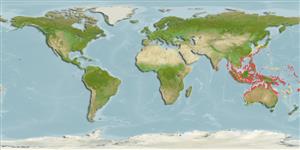Common names from other countries
Environment: milieu / climate zone / depth range / distribution range
Écologie
marin; saumâtre récifal; profondeur 1 - 25 m (Ref. 9407). Tropical
Indo-West Pacific: India eastward through Indonesia to New Guinea, northward to southern Japan, southward to northern Australia.
Taille / Poids / Âge
Maturity: Lm ? range ? - ? cm
Max length : 45.0 cm SL mâle / non sexé; (Ref. 48637)
Épines dorsales (Total) : 0; Rayons mous dorsaux (Total) : 10; Épines anales: 0; Rayons mous anaux: 9 - 10. Body covered with prickles. White lines encircling eye (Ref. 559).
Occurs in shallow water reefs near sand or seaweed areas. Also found in estuaries and protected muddy bays; juveniles in mangroves and entering the lower reaches of streams (Ref. 9407, 48637). Solitary (Ref. 90102). Adults at moderate depths, often laying on the mud during the day (Ref. 48637).
Life cycle and mating behavior
Maturities | Reproduction | Spawnings | Egg(s) | Fecundities | Larves
Masuda, H., K. Amaoka, C. Araga, T. Uyeno and T. Yoshino, 1984. The fishes of the Japanese Archipelago. Vol. 1. Tokai University Press, Tokyo, Japan. 437 p. (text). (Ref. 559)
Statut dans la liste rouge de l'IUCN (Ref. 130435)
CITES (Ref. 128078)
Not Evaluated
Menace pour l'homme
Harmless
Utilisations par l'homme
Pêcheries: sans intérêt
Outils
Articles particuliers
Télécharger en XML
Sources Internet
Estimates based on models
Preferred temperature (Ref.
115969): 25.1 - 29.3, mean 28.6 (based on 2442 cells).
Phylogenetic diversity index (Ref.
82804): PD
50 = 0.5000 [Uniqueness, from 0.5 = low to 2.0 = high].
Bayesian length-weight: a=0.02951 (0.01562 - 0.05576), b=2.89 (2.73 - 3.05), in cm Total Length, based on LWR estimates for this species & Genus-body shape (Ref.
93245).
Niveau trophique (Ref.
69278): 3.4 ±0.5 se; based on size and trophs of closest relatives
Résilience (Ref.
120179): Milieu, temps minimum de doublement de population : 1,4 à 4,4 années (Preliminary K or Fecundity.).
Fishing Vulnerability (Ref.
59153): Moderate vulnerability (42 of 100).
